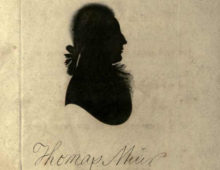Tagged with Reform
Resource : The Rajah Quilt
Transportation was an extremely harsh punishment of the 1700s and 1800s, second only to execution. Between 1787 and 1852 as many as 25,000 women were transported from Britain to Australia to work in penal colonies, for crimes as varied as petty theft and poaching, to murder. Their sentences were often miscarriages of justice. Many didn’t survive the long journey. Most of them never returned. This remarkable quilt was made by women transported to Tasmania in 1841.
Resource : Portrait of Mary Wollstonecraft
Mary Wollstonecraft was a revolutionary writer who made a powerful case for educating and emancipating women. She is still regarded as one of the founders of modern British feminism.
Resource : Description of a Slave Ship
Transatlantic slavery was a brutal system which forcibly shipped over twelve million Africans to the Americas and lasted over 300 years. It allowed African men, women and children to be stolen from their homeland, bought and sold as property and used to produce sugar, coffee, cotton and other goods for huge profit in the European and North American markets. This print was made to highlight the inhumane conditions under which enslaved Africans were transported across the Atlantic Ocean, forced to make the long voyage from West Africa to the Americas, tightly packed into the hold of ships and held in chains.
Resource : Banner from the “Peterloo Massacre”
On the 16th August 1819, a huge crowd of people gathered in St Peter’s Field, Manchester to hear Henry ‘Orator’ Hunt and other noted radical speakers calling for parliamentary reform. At least 17 people would die of injuries received on the day, and around 700 suffered serious wounds at the hands of local armed forces. There was a popular outcry, and the radical press named the incident the ‘Peterloo Massacre’, a mocking reference to the Battle of Waterloo.
Resource : Newgate prison door
Newgate Prison was located on Newgate Street in the City of London, on the site where the famous court, The Old Bailey, now stands. The prison was notorious for its appalling, overcrowded, cruel and unsanitary conditions. It housed a range of prisoners, including men, women and children, from those convicted of minor offenders to those awaiting execution. It would be outside Newgate’s gates that the last British prisoners to suffer beheading took place, when five revolutionary ringleaders accused of a conspiracy to assassinate the Cabinet were executed on 1 May 1820.
Resource : Tokens given by mothers to their children on leaving them at the Foundling Hospital
This is a selection of tokens from mothers who, unable to keep their babies, left them at the Foundling Hospital in London. They highlight the plight of single mothers and destitute families unable to care for their children and are a poignant reminder of the growing poverty crisis as cities became more heavily industrialised and workers more mobile during the Age of Revolution. Many babies were left anonymously by their mothers, along with a token to identify them, in the hope that they might be reunited in the future.
Resource : Poster advertising the Chartists’ Demonstration on Kennington Common, 1848
The Chartists were members of a national and generally peaceful protest movement who campaigned between 1838 and 1857 for political reform and representation of working class people. It was the first British mass movement to be driven by the working classes. The development of the industrial printing press helped spread the word and gather support for peaceful protests. The Chartists’ ‘demands’ still underpin British democracy today.
Resource : Olympe de Gouges
Olympe de Gouges was a radical feminist and one of the first people to fight for equal rights for women. She campaigned against violence and oppression and spoke out against slavery. But despite her pacifist views, her radical ideas eventually led to her death, at the guillotine, in revolutionary France.
Resource : Drawer handle with abolitionist plaque
In the late 1700s, the image of a kneeling, enslaved African man, accompanied by the words ‘Am I not a man and a brother’ became the most prominent emblem for those wishing to abolish the Transatlantic slave trade, in both Britain and America. As well as appearing in books, prints and pamphlets, it was also reproduced on an extraordinary variety of everyday and household items – from crockery and soft furnishings, to jewellery and hairpins.
Resource : Welsh project digitises documents from the Newport Chartist Uprising of 1839
May 7, 2019 - Richard Moss
This fascinating project, which launched in 2016 in Wales, has seen volunteers working to transcribe more than 3,000 important documents gathered together shortly after the famous Newport Chartist Rising of November 3rd and 4th 1839. Unlocking the Chartist Trials uses online volunteers to transcribe the court records relating to the famous Rising, which is cited […]


